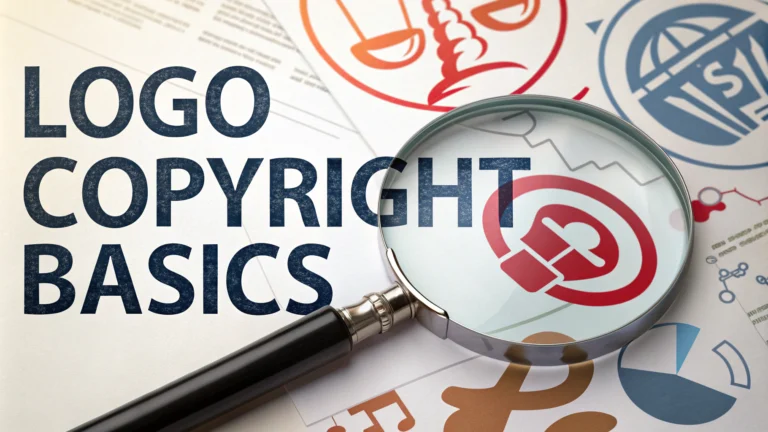Understanding logo copyright protects your business identity and prevents legal issues down the road.
Basic Copyright Protection
A logo receives automatic copyright protection as soon as it’s created in a tangible form.
- Original artwork is protected immediately
- Registration provides additional legal benefits
- Protection lasts for the creator’s life plus 70 years
Registration Benefits
Registering your logo with the U.S. Copyright Office (copyright.gov) provides several advantages:
- Ability to sue for copyright infringement
- Statutory damages up to $150,000 per violation
- Legal proof of ownership
- Public record of your copyright claim
Common Misconceptions
Simply paying for a logo design doesn’t automatically transfer copyright ownership to you.
- Get written transfer of rights from the designer
- Specify “work for hire” in contracts
- Request all source files upon completion
Protecting Your Logo
- Use the © symbol with your logo
- Document creation dates and drafts
- Monitor for unauthorized use
- Send cease and desist letters for violations
Additional Protection Methods
Consider these complementary forms of protection:
- Trademark Registration: Protects your logo as a business identifier
- Design Patent: Protects ornamental design elements
- Trade Dress: Protects distinctive visual appearance
International Protection
U.S. copyright registration doesn’t automatically protect your logo worldwide.
- Register in countries where you do business
- Consider the Madrid Protocol for international trademark protection
- Check local copyright laws and requirements
Legal Resources
For professional assistance, contact:
- U.S. Copyright Office: 1-877-476-0778
- USPTO: 1-800-786-9199
- American Bar Association IP Section: www.americanbar.org
Enforcement Actions
When you discover unauthorized use of your logo, take these steps:
- Document all instances of infringement
- Gather evidence of damages and lost revenue
- Consult with an intellectual property attorney
- Consider mediation before litigation
Digital Protection Strategies
Implement these measures to protect your logo online:
- Use watermarks on digital versions
- Employ right-click protection on websites
- Register with online copyright monitoring services
- Include logo usage terms in website policies
Logo Licensing
When allowing others to use your logo, establish clear guidelines:
- Create detailed licensing agreements
- Specify permitted uses and restrictions
- Set quality control standards
- Define term limits and termination conditions
Conclusion
Protecting your logo requires a multi-faceted approach combining copyright registration, active monitoring, and proper legal documentation. Stay vigilant in enforcement efforts and consider multiple forms of intellectual property protection to fully secure your brand identity.
- Register your copyright promptly
- Maintain thorough documentation
- Implement preventive measures
- Seek professional legal guidance when needed
FAQs
- Can I trademark or copyright my logo design?
You can do both. Trademarks protect logos as identifying marks in commerce, while copyright protects the artistic elements of the logo. Most businesses choose to trademark their logos for stronger commercial protection. - When does copyright protection for a logo begin?
Copyright protection begins automatically the moment your original logo is created and fixed in a tangible form, whether digital or physical. - How long does copyright protection last for a logo?
For logos created by individuals, copyright lasts for the creator’s lifetime plus 70 years. For works created by employees or work-for-hire, copyright lasts 95 years from publication or 120 years from creation, whichever is shorter. - Do I need to register my logo copyright?
Registration isn’t required for copyright protection, but it provides important benefits like the ability to sue for infringement, statutory damages, and attorney fees in federal court. - What happens if someone copies my copyrighted logo?
If your logo is copied without permission, you can take legal action for copyright infringement, especially if you’ve registered your copyright. You can seek damages and request the infringing party to cease using your logo. - Who owns the copyright if I hire a designer to create my logo?
Unless there’s a written agreement stating otherwise, the designer owns the copyright. For businesses, it’s essential to have a written contract transferring copyright ownership from the designer to the company. - Can I use copyrighted elements in my logo design?
No, you cannot use copyrighted elements in your logo without explicit permission from the copyright holder. Doing so could result in legal action for copyright infringement. - What’s the difference between the © symbol and the ™ symbol for logos?
The © symbol indicates copyright protection for the artistic elements, while ™ (trademark) indicates the logo is being used as a commercial identifier. The ® symbol is used for registered trademarks. - Are simple logos eligible for copyright protection?
Very simple logos may not qualify for copyright protection if they lack sufficient creative expression. However, they might still be protected under trademark law for commercial purposes. - Can I copyright my logo internationally?
While copyright protection is automatic in countries that signed the Berne Convention, you may need to register your copyright in specific countries for enhanced protection and enforcement rights.







